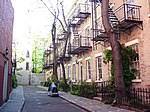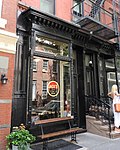Ninth Ward School disaster
The Ninth Ward School disaster occurred on November 20, 1851, at Ward School No. 26 on Greenwich Street in New York City. While classes were in session, panic suddenly arose among the teachers and students about a possible fire in the building. A mass of students proceeded to flee down a staircase, causing the bannister to fail and the students to tumble into a large pile—reportedly 10 to 12 feet (3.0 to 3.7 m) deep—at the bottom of the staircase. Forty-three students died, mostly due to suffocation. An investigation determined that the students' escape had been slowed by inward-swinging exit doors and that the construction of the staircase bannister was insufficient to support to the weight of the students. While a coroner's jury found no fault in the accident, it recommended that all schools be built with fire-protected stairways and outward-opening exit doors.
Excerpt from the Wikipedia article Ninth Ward School disaster (License: CC BY-SA 3.0, Authors).Ninth Ward School disaster
West 11th Street, New York Manhattan
Geographical coordinates (GPS) Address Website Nearby Places Show on map
Geographical coordinates (GPS)
| Latitude | Longitude |
|---|---|
| N 40.735416666667 ° | E -74 ° |
Address
Public School 41 (Greenwich Village School)
West 11th Street 116
10011 New York, Manhattan
New York, United States
Open on Google Maps







